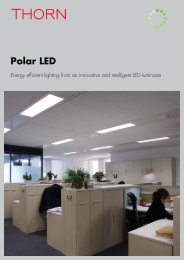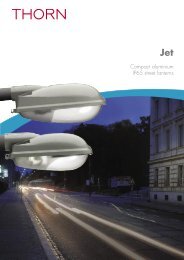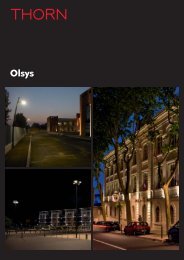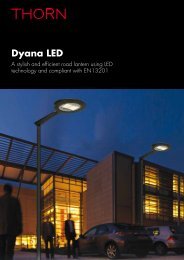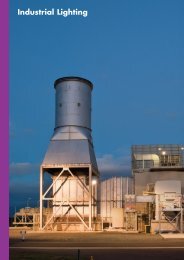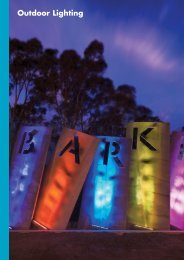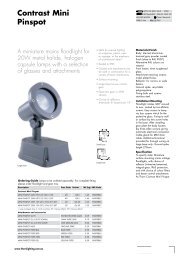Building Code of Australia - THORN Lighting
Building Code of Australia - THORN Lighting
Building Code of Australia - THORN Lighting
You also want an ePaper? Increase the reach of your titles
YUMPU automatically turns print PDFs into web optimized ePapers that Google loves.
Introduction<br />
<strong>Lighting</strong> is an essential part <strong>of</strong> the modern society, allowing<br />
us to turn night into day, which allows us to do more each<br />
day. Our patterns <strong>of</strong> work and leisure are made possible<br />
through our ability to control our environment and supply<br />
light on demand.<br />
But the use <strong>of</strong> light is constantly challenging us. It is<br />
no longer enough to ensure good task visibility, or a<br />
comfortable environment. We need to achieve all <strong>of</strong> these,<br />
but also in a way that minimises harm to the environment.<br />
Thorn is already doing its part by focusing on its PEC<br />
approach. PEC – Performance, Efficiency, Comfort – is<br />
the dynamic, results orientated programme that underpins<br />
Thorn’s approach to lighting design and implementation.<br />
PEC reconciles the need for low direct and environmental<br />
costs with the need to deliver workplace and public lighting<br />
that promotes efficiency, safety, a healthy environment and<br />
productivity. With statutory and environmental pressures<br />
increasing, PEC <strong>of</strong>fers Thorn customers the ability to<br />
provide optimum lighting solutions for people and places<br />
while conserving energy, cash and raw materials.<br />
In <strong>Australia</strong> the <strong>Building</strong> <strong>Code</strong> <strong>of</strong> <strong>Australia</strong> (BCA) sets the<br />
technical provisions for the design and construction <strong>of</strong><br />
buildings and other structures throughout <strong>Australia</strong>.<br />
This booklet has been put together to help people in the<br />
lighting industry better understand the requirements outlined<br />
under part J6.2b <strong>of</strong> the BCA.<br />
It is important to note that this booklet only covers part J6.2b<br />
<strong>of</strong> the BCA, which is only aimed at commercial, retail and<br />
industrial type buildings,<br />
ie. class 4, 5, 6, 7, 8, 9a<br />
and 9b. Furthermore, it is<br />
recommended that further<br />
information is obtained<br />
from the <strong>Australia</strong>n <strong>Building</strong><br />
<strong>Code</strong>s Board to ensure<br />
compliance with any<br />
requirements.<br />
When Does J6.2b Affect You?<br />
When a client contracts or tenders a building<br />
project under the design and construct method.<br />
Electrical Contractors must ensure they do not exceed the<br />
maximum illuminated power densities as set out in Part J6<br />
Table 6.2b <strong>of</strong> the <strong>Building</strong> <strong>Code</strong> <strong>of</strong> <strong>Australia</strong>.<br />
6 7<br />
OR<br />
When the electrical contractor substitutes a<br />
light fitting specified by an electrical engineer<br />
or architect.<br />
Basic Watts per/m 2 Calculations<br />
TOTAL WATTS OF ALL<br />
LIGHTING LUMINAIRES<br />
÷<br />
AREA (m 2 )<br />
=<br />
WATTS/m² X Adjustment factors*<br />
* Adjustment factors are used to improve the Watts/m² output<br />
<strong>of</strong> an application. Refer to page 10 for further details on<br />
adjustment factors.



